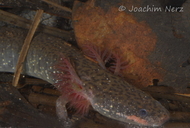|
Siren intermedia Barnes, 1826
Lesser Siren, Eastern Lesser Siren, Western Lesser Siren | family: Sirenidae genus: Siren |
 © 2016 Dr. Joachim Nerz (1 of 26) |
|
|
|
Description The dorsal ground color of adults is variable, ranging from olive green to grayish blue or black. Brown or black spots can be seen scattered on the dorsum of lighter colored individuals. The venter is lighter than the back and white or yellowish flecks may occur on the sides (Martof 1973; Petranka 1998). Hatchlings and juveniles are more brightly colored than adults, having light stripes along the body and yellow or red banding on the head (Martof 1973; Petranka 1998). The bright colors and stripes fade and the dorsal fin on the back is lost as animals age (Petranka 1998). Two or three subspecies are recognized and can be distinguished based on distribution (see below), size, and coloration. Siren i. intermedia, the eastern lesser siren, is a dark colored form, sometimes having tiny black spots on the dark brown or black dorsum. The venter is also dark, without spots or mottling, and lighter than the dorsum. Maximum length is about 38 cm, and the modal number of costal grooves is 32-33. Siren i. nettingi, the western lesser siren, is olive green to gray with tiny black spots on the dorsum. The venter is also dark with numerous light flecks. Maximum length is 50 cm, with a modal number of 35 costal grooves. Siren i. texana, the Rio Grande siren, is the largest subspecies, reaching 69 cm total length, and having a modal costal groove count of 37. The dorsum is gray to brownish gray with tiny black spots and the venter is light gray. Descriptions from Petranka (1998) Distribution and Habitat Country distribution from AmphibiaWeb's database: Mexico, United States U.S. state distribution from AmphibiaWeb's database: Alabama, Arkansas, Florida, Georgia, Illinois, Indiana, Kentucky, Louisiana, Michigan, Missouri, Mississippi, North Carolina, Ohio, Oklahoma, South Carolina, Tennessee, Texas, Virginia
Lesser sirens are found in a diversity of permanent and semi-permanent aquatic habitats including swamps, marshes, ditches, canals, sloughs, farm ponds, temporary pools in floodplains, and shallow heavily vegetated ponds with deep sediments into which they burrow. See Petranka, (1998) and references therein. Life History, Abundance, Activity, and Special Behaviors Biting of females by males apparently occurs during the mating season (Godley 1983; Fauth and Resetarits 1999), but bite marks have also been reported on males (Raymond 1991; Fauth and Resetarits 1999). This and the fact that biting also occurs outside of the mating season (on males and females) suggests that there is male-female and male-male aggression; females have not been found to bite other females (Fauth and Resetarits 1999). When temporary water bodies dry, sirens burrow into soft mud and can aestivate for several months until the ponds fills again (Petranka 1998). Diet of sirens includes a variety of aquatic invertabrates both benthic and pelagic (Petranka 1998).Sirens are locally abundant and densities have been estimatied as 0.9-1.3 sirens/m2(Gehlbach and Kennedy 1978).Sirens are known to vocalize, and they emit barks, yelps, and clicks in intraspecific interactions and also when disturbed (Petranka and references therein 1998). Trends and Threats Relation to Humans
References
Fauth, J. E. and Resetarits, W. J., Jr. (1999). ''Biting in the salamander Siren intermedia intermedia: Courtship component or agonistic behavior?'' Journal of Herpetology, 33, 493-496. Flores-Villela, O., and Brandon, R.A. (1992). ''Siren lacertina (Amphibia: Caudata) in northeastern Mexico and southern Texas.'' Annals of Carnegie Museum, 61, 289-291. Gehlbach, F. R., and Kennedy, S. E. (1978). ''Population ecology of a highly productive aquatic salamander (Siren intermedia).'' Southwestern Naturalist, 23, 423-430. Godley, J. S. (1983). "Observations on the courtship, nests and young of Siren intermedia in southern Florida." American Midland Naturalist, 110, 215-219. Martof, B. S. (1973). ''Siren intermedia Le Conte. Lesser Siren.'' Catalogue of American Amphibians and Reptiles. Society for the Study of Amphibians and Reptiles, 127.1-127.3. Martof, B. S. (1974). ''Siren Linnaeus. Sirens.'' Catalogue of American Amphibians and Reptiles. Society for the Study of Amphibians and Reptiles, 152.1-152.2. Martof, B. S. (1974). ''Sirenidae. Sirens.'' Catalogue of American Amphibians and Reptiles. Society for the Study of Amphibians and Reptiles, 151.1-151.2. Petranka, J. W. (1998). Salamanders of the United States and Canada. Smithsonian Institution Press, Washington D.C. and London. Raymond, L. R. (1991). "Seasonal activity of Siren intermedia in northwestern Louisiana (Amphibia: Sirenidae)." Southwestern Naturalist, 36, 144-147. Sever, D. M., Rania, L. C. and Krenz, J. D. (1996). ''Reproduction of the salamander Siren intermedia Le Conte with especial reference to oviducal anatomy and mode of fertilization.'' Journal of Morphology, 227, 335-348. Originally submitted by: Meredith J. Mahoney (first posted 2000-01-17) Edited by: M. J. Mahoney, Kevin Gin (12/03) (2003-12-04) Species Account Citation: AmphibiaWeb 2003 Siren intermedia: Lesser Siren <https://amphibiaweb.org/species/4315> University of California, Berkeley, CA, USA. Accessed Jun 16, 2025.
Feedback or comments about this page.
Citation: AmphibiaWeb. 2025. <https://amphibiaweb.org> University of California, Berkeley, CA, USA. Accessed 16 Jun 2025. AmphibiaWeb's policy on data use. |




 Raffaëlli Account
Raffaëlli Account Map of Life
Map of Life